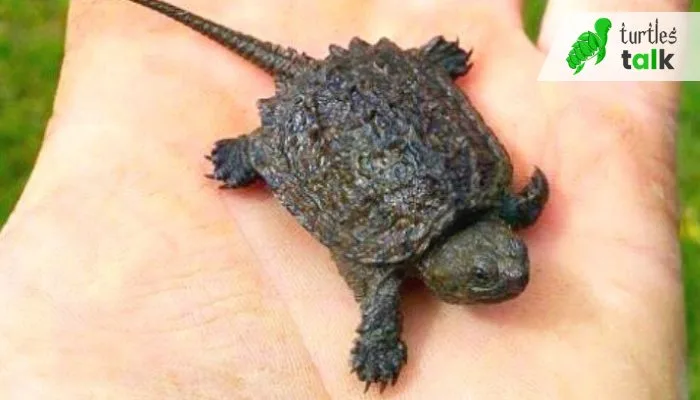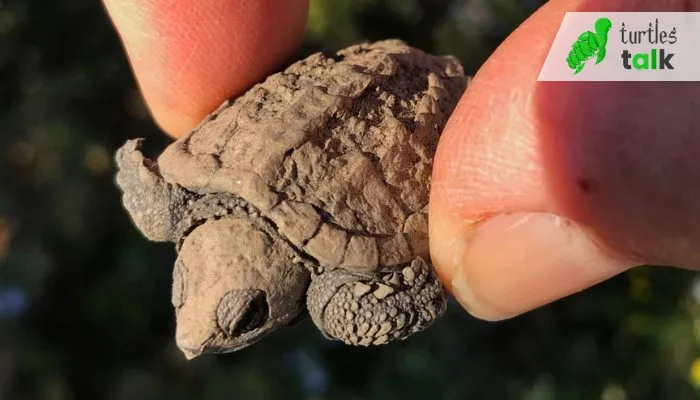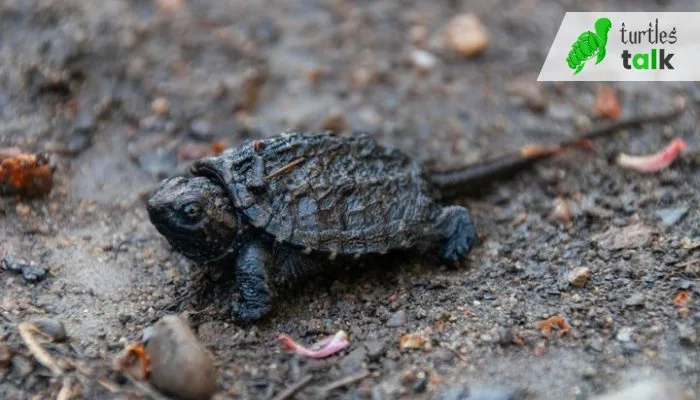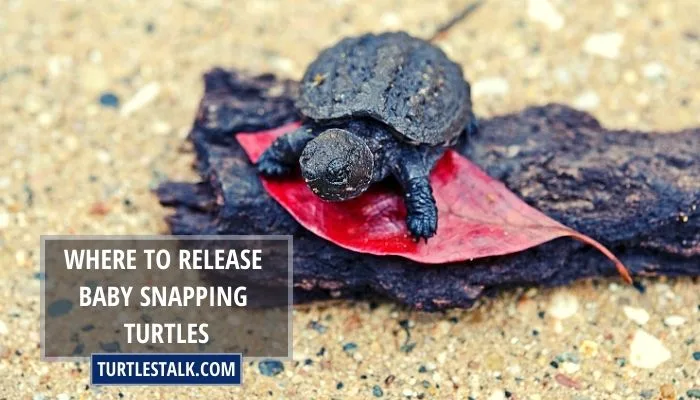Where To Release Baby Snapping Turtles? – Best Places For Baby Turtle Release
When people discover baby snapping turtles hidden beneath water lilies or basking in the sun, they wonder what to do with them. These reptiles are on the brink of survival and have to be carefully returned to their natural habitat.
The best place to release baby snapping turtles is in the wild. But since they can’t be left to fend for themselves, they have to be carefully transported to a suitable habitat. When done correctly, releasing these animals can give them a better chance at survival and help preserve the delicate habitats and ecosystems that depend on them.
To ensure that your release is successful, it is important to research potential release sites and consider the requirements for a safe and successful release.
What is the Suitable Location for Releasing Baby Snapping Turtles?
The suitable location for releasing baby snapping turtles depends on various factors, such as the species of the turtle, the surrounding environment, and the availability of suitable habitats. Here are some general guidelines to consider when choosing a location for releasing baby snapping turtles:

Choose a location near a water source
Snapping turtles are aquatic animals and need access to water for feeding, hydration, and basking. Therefore, it is essential to release baby snapping turtles near a suitable water source such as a pond, lake, river, or wetland.
Look for suitable habitats
These turtles prefer habitats with a mix of shallow and deep water, ample aquatic vegetation, and plenty of basking sites such as logs, rocks, and shorelines. Look for locations with a variety of habitats that can support the turtle’s needs throughout its life.
Avoid heavily polluted areas
Turtles are sensitive to pollution and contaminants in the water. Avoid releasing baby snapping turtles in heavily polluted areas such as industrial sites, wastewater discharge points, and areas with high levels of agricultural runoff.
Choose a location with low human traffic
Baby turtles are vulnerable to predation, and human activity can disturb their habitat and put them at risk. Choose a location with low human traffic to minimize disturbance and maximize their chances of survival.
Consult with local authorities
Depending on your location, regulations or guidelines for releasing turtles may exist. Consult with local authorities or wildlife experts to ensure that you are following the appropriate protocols.
How Do You Release a Snapping Turtle?
Snapping turtles are relatively docile creatures but can be territorial, aggressive, and potentially dangerous animals. As such, handle them carefully and release them back into the wild in the same location they were caught.

It is essential to ensure that the turtle’s release is done in a safe way for both the turtle and the people involved.
Here, we provide a step-by-step guide to safely releasing a snapping turtle.
Step 1: Check Local Regulations
Before releasing this turtle, check local regulations. Different states and local municipalities may have restrictions on the release of these turtles. It is essential to be aware of any specific regulations before attempting to release a snapping turtle.
Step 2: Locate an Appropriate Release Site
Once the regulations are understood, locate an appropriate release site. For the health and safety of the turtle, the release site should be free of potential hazards such as traffic or predators.
It is also necessary to consider the local environment to ensure a suitable habitat. If possible, locate a body of water nearby where the turtle can find food and shelter.
Step 3: Prepare the Turtle for Release
Before releasing the turtle, make sure it is in good health. Carefully check the turtle for any signs of injury and ensure it is free of any potential parasites or diseases. Contact a local wildlife rehabilitation center before releasing the turtle if medical attention is needed.
Step 4: Release the Turtle
Once the turtle is safe and healthy, it is time to release it back into the wild. Prior to releasing the turtle, take any necessary precautions to ensure a successful transition. Introduce the turtle to its new environment slowly.
Ways to Help Baby Snapping Turtles Survive in the Wild
Baby snapping turtles are an important part of the ecosystem and are essential for maintaining healthy aquatic habitats. Unfortunately, due to human activity, their numbers have been steadily declining.
There are a number of ways we can help baby snapping turtles survive in the wild.
Don’t Collect Them from the Wild
These turtles are not suitable for pets—capturing and keeping them in captivity can have a negative impact on their populations. Instead, enjoy them in their natural habitats and help them survive by not collecting them yourself.
Avoid Disturbing Their Environment
They are sensitive to their environment—they can be disturbed by noise, activity, or light. Do your best to avoid disturbing their habitat and respect their space.
Encourage Local Efforts to Protect Them
Local conservation efforts can positively impact snapping turtles in the wild. Encourage local efforts to protect them and help them thrive in their natural habitats.
Support Legal Turtle Harvesting
Harvesting these turtles for their meat is legal in many states, with strict regulations in place to ensure the turtles are harvested sustainably. Support legal turtle harvesting, and enjoy the meat while helping to support local economies and turtle populations in the wild.
What is the appropriate setting for releasing juvenile snapping turtles?
Baby snapping turtles should be released into water that is at least 18 inches deep—ideally 24 inches deep—with a soft substrate that allows them to burrow into and hide if necessary. These turtle species are considered invasive in most areas and should be released only by an expert familiar with their needs.
If you find baby snappers in your pond, it is best to contact a wildlife rehabilitator or a herpetologist for advice on how to proceed with their release.
If you have no experience with this type of turtle and are not able to contact an expert, it’s best to assume the turtle is a non-native species and humanely euthanize it.
What Are the Predators of Baby Snapping Turtles?
Snapping turtles have a few predators in the wild—including foxes, coyotes, snakes, raccoons, and large birds—such as herons and eagles. Since they’re unable to protect themselves fully, baby snapping turtles are at high risk of being eaten by other animals.

The only thing that can truly protect a baby snapping turtle from predators is hiding in—or burrowing into—soil. This hiding technique is referred to as “lymnication”, and it’s an effective survival tactic used by many species of turtles.
Once they reach a certain age and size, they’re able to hide or burrow into the soil on their own.
What to Do if You Find a Snapping Turtle in Your Yard?
It’s best to leave the snapping turtle alone if you find it in your yard. Snapping turtles are typically not aggressive toward humans but can inflict injuries if provoked.
If you find one in your yard, here are some steps to follow:
Observe from a safe distance
Snapping turtles have strong jaws and can be aggressive if they feel threatened, so it is important to give them space.
Determine if it’s a pet
If the turtle has a tag or a painted shell, it’s possible that it is a lost pet. Contact local animal control or wildlife rehabilitation centers for assistance.
Leave it be
If the turtle is healthy and not in danger, it is best to leave it alone and let it continue on its way.
Relocate it
If the turtle is in a dangerous location, such as a busy road, you can carefully pick it up using gloves or a towel and move it to a nearby safe location, such as a pond or stream.
Do not take it as a pet
Snapping turtles are protected species; removing them from the wild is illegal in many states.
Seek assistance
Contact a local wildlife rehabilitation center for assistance if the turtle is injured or appears to be sick.
How fast do baby snapping turtles grow before they can be released into the wild?
The growth spurt of snapping turtles determines when they can be released into the wild. Baby snapping turtles hatch from eggs and typically grow at a slow rate in their first year. However, during their second year, they experience a growth spurt, reaching around 6 to 8 inches in size. Once they reach this stage, they are strong enough to fend for themselves in the wild.
Conclusion
Releasing baby snapping turtles in the wild is the best way to ensure their survival and a great way to help preserve the species. Remember to consider the release location’s environment and the turtles’ needs.
The best places to release these turtles are in a body of water with plenty of aquatic vegetation and a soft, sandy bottom, as this will provide the best conditions for the turtles to thrive.
By following the tips presented in this article, you can release your rescued turtle back into the wild. If you found this article helpful, share it with others. Thanks for reading!

